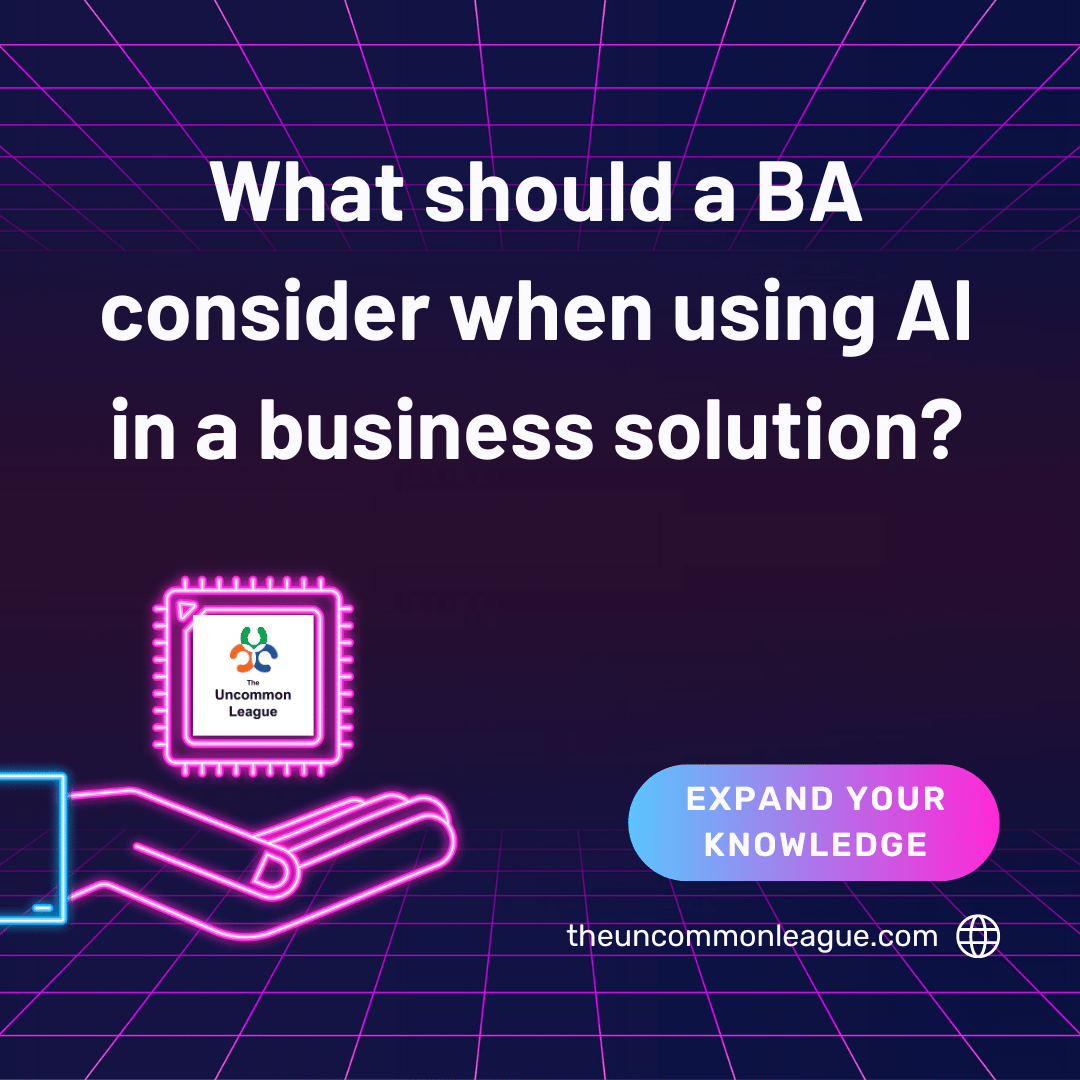What should a Business Analyst consider when using AI in their business solution?
As business analysts embark on the journey of incorporating AI into their business solutions, a myriad of considerations must be taken into account. In this article, we'll explore the factors that business analysts should consider when leveraging AI in their business solutions, examining the pros and cons of adding AI to existing applications and integrating this transformative technology into organizations where AI is still new.
Understanding the Potential of AI
Before diving into the practical considerations of implementing AI, it's crucial for business analysts to understand the potential that AI brings to the table. AI has the power to analyze vast amounts of data, uncover hidden patterns, and make predictions with unprecedented accuracy. It can automate repetitive tasks, streamline workflows, and empower decision-making with actionable insights. By harnessing the capabilities of AI, business analysts can unlock new opportunities for innovation and drive tangible business outcomes.
Application Integration Approaches
API Integration: Utilize AI services and APIs provided by AI platforms or service providers to seamlessly integrate AI functionalities into the application.
Custom Development: Develop custom AI solutions tailored to the specific requirements of each functionality, leveraging AI frameworks and libraries to build AI models and algorithms.
User Testing and Feedback: Conduct extensive user testing and gather feedback to ensure that AI functionalities are user-friendly, accurate, and meet the needs of the target audience. Iterate on the design and implementation based on user feedback to continuously improve the AI integration.
Pros of Adding AI to Existing Applications
One of the key advantages of adding AI to existing applications is the ability to enhance functionality and deliver a more personalized user experience. AI-powered features such as recommendation engines, predictive analytics, and natural language processing can enrich existing applications, making them more intelligent and responsive to user needs. Additionally, integrating AI into existing applications allows organizations to leverage their existing infrastructure and data assets, minimizing the need for costly redevelopment efforts.
Cons of Adding AI to Existing Applications
However, adding AI to existing applications is not without its challenges. One of the main hurdles is ensuring compatibility and integration with existing systems and processes. Business analysts must carefully assess the impact of introducing AI on existing workflows, data pipelines, and user interfaces, and address any potential conflicts or dependencies that may arise. Additionally, integrating AI into legacy systems may require significant time, resources, and technical expertise, posing challenges in terms of implementation complexity and project management.
Business Analysts should also take into consideration data security and privacy when soldiering integrating with external AI vendors. Compliance and regulations such as GDPR, CCPA, HIPAA, PHI, and PCI DSS along with state and local laws should be carefully considered before integrating AI into an application. Some compliance and regulatory bodes conduct audits to ensure compliance which might be another point to consider in designing an AI interface. You may be required to build in processes that would assist with these audits.
Considerations for Organizations New to AI
For organizations where AI is still new, introducing this transformative technology requires careful planning and preparation. Business analysts must assess the organization's readiness for AI adoption, considering factors such as data infrastructure, technical capabilities, and organizational culture. It's essential to educate stakeholders about the benefits and implications of AI, fostering a culture of innovation and experimentation.
Introducing AI into an Organization
Introducing AI technology into an organization requires a strategic and systematic approach to ensure successful adoption and integration. Below are the key steps and best practices for introducing AI technology into an organization:
Define Clear Objectives and Use Cases:Start by identifying specific business objectives and use cases where AI can provide value. Clearly define the problems or opportunities that AI technology aims to address and prioritize them based on business impact and feasibility.
Assess Organizational Readiness: Evaluate the organization's readiness for AI adoption, including factors such as data maturity, technical infrastructure, skills and expertise, culture, and leadership support. Identify any gaps or challenges that need to be addressed before implementing AI solutions
Build Cross-Functional Teams: Establish cross-functional teams comprising stakeholders from business units, IT, data science, and other relevant departments. Collaborate closely with these teams to ensure alignment between business goals and AI initiatives and to facilitate communication and collaboration throughout the implementation process.
Invest in Talent and Skills Development: Identify and invest in talent development initiatives to build the necessary skills and expertise for AI adoption. This may involve training existing employees, hiring data scientists and AI specialists, or partnering with external vendors and consultants.
Start Small and Iterate: Begin with pilot projects or proof-of-concept initiatives to test AI technologies in real-world scenarios and demonstrate value. Start small and focus on quick wins to build momentum and gain buy-in from stakeholders. Iterate based on feedback and lessons learned from pilot projects.
Select the Right AI Solutions: Evaluate and select AI solutions that align with organizational goals, requirements, and capabilities. Consider factors such as scalability, interoperability, security, compliance, vendor reputation, and total cost of ownership. Choose AI technologies that are flexible and adaptable to evolving business needs.
Ensure Data Quality and Governance: Prioritize data quality and governance to ensure that AI algorithms receive accurate, relevant, and reliable data for training and decision-making. Establish data governance policies, processes, and controls to maintain data integrity, privacy, and security throughout the AI lifecycle.
Monitor and Measure Performance: Implement performance metrics and key performance indicators (KPIs) to measure the impact of AI initiatives on business outcomes. Continuously monitor AI models, algorithms, and applications to assess performance, identify opportunities for optimization, and address any issues or biases that may arise.
Promote Transparency and Ethical Use of AI: Foster a culture of transparency and ethical use of AI within the organization. Communicate openly with employees, customers, and other stakeholders about how AI technology is being used, its limitations, and the measures in place to ensure fairness, accountability, and transparency.
Scale and Institutionalize AI Adoption: Once initial AI initiatives prove successful, scale up adoption across the organization. Develop a roadmap for scaling AI initiatives, prioritize investments in areas with the highest potential for impact, and embed AI capabilities into business processes and workflows.
Pros of Introducing AI to New Organizations
Despite the challenges, introducing AI to organizations where it is still new offers numerous benefits. AI has the potential to revolutionize business processes, drive efficiency, and unlock new opportunities for growth. By embracing AI early on, organizations can gain a competitive edge in their industry, positioning themselves as leaders in innovation and technology adoption. Additionally, starting with a clean slate allows organizations to design AI solutions from the ground up, leveraging best practices and avoiding the constraints of legacy systems.
Cons of Introducing AI to New Organizations
However, introducing AI to new organizations comes with its own set of challenges. One of the main obstacles is building the necessary infrastructure and expertise to support AI initiatives. This may require significant investment in technology, talent, and training, as well as a shift in organizational mindset and culture. Additionally, organizations must navigate ethical considerations and regulatory requirements surrounding AI, ensuring that AI solutions adhere to privacy, security, and compliance standards.
Organizational Fears of Using AI
Organizations may have several common fears and concerns about AI adoption, including:
Job Displacement: One of the most significant fears is that AI technology will replace human jobs, leading to unemployment and workforce displacement.
Data Privacy and Security: Organizations may worry about the potential risks associated with storing and processing sensitive data using AI systems, including data breaches, privacy violations, and regulatory non-compliance.
Bias and Fairness: There's a concern that AI algorithms may perpetuate or amplify existing biases present in the training data, leading to unfair or discriminatory outcomes.
Lack of Transparency: The "black box" nature of some AI algorithms may create uncertainty about how AI systems arrive at their decisions, making it difficult to interpret or explain their reasoning.
Reliability and Accuracy: Organizations may question the reliability and accuracy of AI systems, especially in critical applications such as healthcare, finance, and autonomous vehicles.
Ethical and Moral Implications: AI raises complex ethical and moral questions, such as the potential for autonomous AI systems to make life-or-death decisions or the impact of AI on societal values and norms.
To overcome these fears and concerns, organizations can take several steps:
Education and Awareness: Provide comprehensive education and training to employees at all levels of the organization to increase understanding of AI technology, its capabilities, limitations, and potential impact on jobs and workflows.
Transparency and Explainability: Foster transparency and explainability in AI systems by using interpretable algorithms, providing explanations for AI-driven decisions, and implementing mechanisms for auditing and validating AI models.
Ethics and Governance: Establish clear ethical guidelines, principles, and governance frameworks for the responsible use of AI technology. This includes addressing issues such as bias mitigation, fairness, accountability, and transparency in AI systems.
Data Privacy and Security Measures: Implement robust data privacy and security measures to protect sensitive data throughout the AI lifecycle, including encryption, access controls, data anonymization, and compliance with regulations such as GDPR and CCPA.
Human-AI Collaboration: Emphasize the importance of human-AI collaboration and the augmentation of human capabilities by AI technology, rather than replacement. Highlight the ways in which AI can enhance productivity, decision-making, and innovation when used in conjunction with human expertise.
April 15 - 17, 2024 (3 Days)
9:00 am (Central) until 5:00pm (Central)
Online - Live Instructor
Continuous Monitoring and Evaluation: Implement mechanisms for continuous monitoring, evaluation, and improvement of AI systems to ensure reliability, accuracy, and fairness. This includes ongoing testing, validation, and iteration of AI models based on feedback and real-world performance.
Engagement and Stakeholder Involvement: Involve employees, customers, regulators, and other stakeholders in the AI adoption process through open dialogue, feedback mechanisms, and collaboration. Address concerns, solicit input, and demonstrate a commitment to ethical and responsible AI use.
Embracing the AI Revolution
Incorporating AI into business solutions offers immense potential for innovation and growth, but it also presents unique challenges and considerations for business analysts. Whether adding AI to existing applications or introducing it to new organizations, careful planning, stakeholder engagement, and technical expertise are essential for success. By understanding the pros and cons of AI adoption and taking a strategic approach to implementation, business analysts can harness the transformative power of AI to drive tangible business outcomes and unlock new opportunities for success in the digital age.
Tags #businessanalysis #ai


